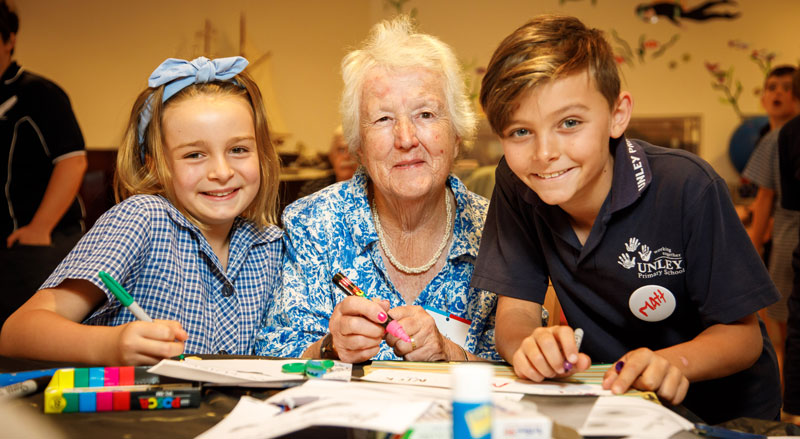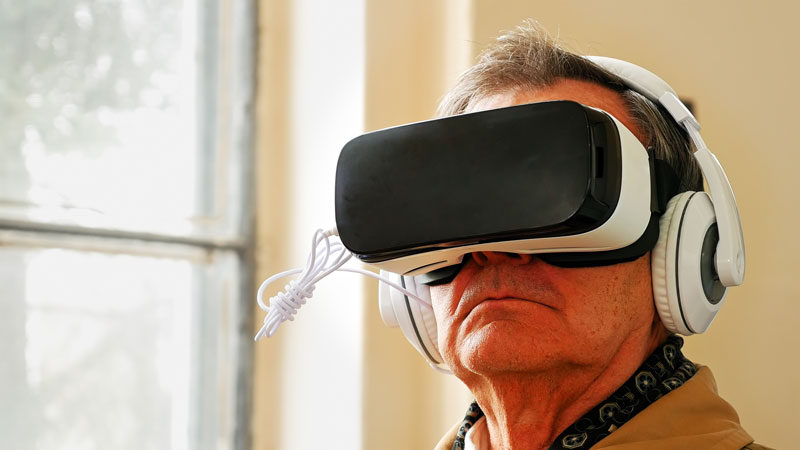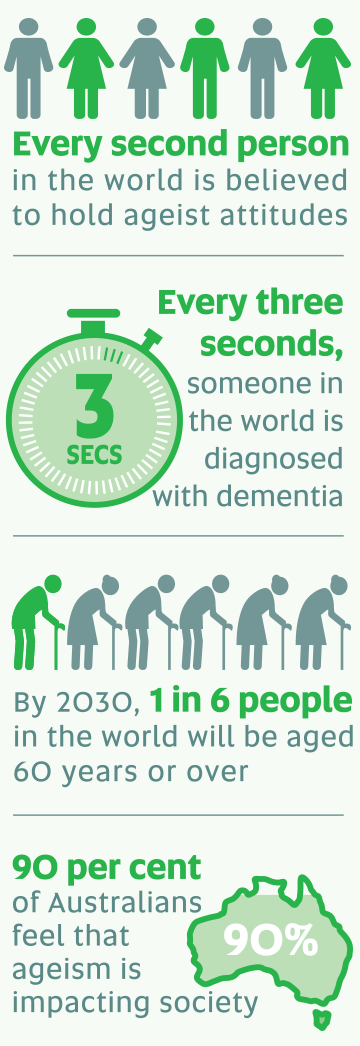Article Lead In
22 November 2021
AUTHOR: ANNABEL MANSFIELD
While our oldest and youngest generations may seem worlds apart, new ageing well initiatives are bringing them together in a timely move to create meaningful connections.
Picture this: A group of young kids crowd around a pool table while an older man takes the first shot of the game, promising to show them “how it’s done”. He pockets three balls in a single shot before passing the cue to one of his young companions.
It’s a happy scene: young and old enjoying each other’s company. But while it could be a family get together – it’s not. The gathering is the result of a carefully conceived intergenerational education program, one of many designed by UniSA researchers to help build and sustain meaningful connections across generations.

And it’s no small feat. From kindergartens to residential care villages, people have been conditioned to learn, socialise and grow with their peers. In some ways this makes sense, allowing for age-appropriate development and learning, like-minded conversations and appropriate care where needed. But age-based segregation can create barriers, something that cognitive ageing expert, UniSA’s Dr Ashleigh Smith, says society needs to correct.
“Society has many well-established constructs where age groupings are necessary and important, but to maintain a well-functioning and cohesive community, we need to start thinking differently about cross-generational interactions,” Dr Smith says.
“In today’s fast-paced world, people work longer, they have fewer hours to spend with their family, and are more likely to engage in social media than spend time catching up with people face-to-face. Add to this an ageing population, and the reality is more of isolation and loneliness, than connection.”
In Australia, social isolation and loneliness are considered significant health and wellbeing issues affecting the mental and physical health of young and old. About one in three people experience loneliness during their lives but these numbers increased during the COVID-19 pandemic.
An age-friendly future starts with children
Building more connected communities can help tackle isolation, but to make this happen, society needs to create more opportunities for older and younger people to connect.
This is where the University’s program comes in. Developed in partnership with the City of Unley, Unley Primary School, SA Health’s Office for Ageing Well and aged care provider ECH, Forget me not aims to build awareness and understanding between primary school-aged children and older people living with dementia.
The brainchild of Dr Smith, the program actively responds to Australia’s ageing population.
“Australia has one of the highest life expectancies in the world, but hand in hand with an older demographic comes a range of health issues, one of which is dementia,” Dr Smith says. “There’s no cure or medicine to prevent dementia, so the best strategy is to educate the next generation on how to live and age well.”
A healthy mind, body and spirit are key to living well but all three can decline with age. Having a purpose, feeling connected and having a reason to get out of bed can make all the difference – this is where intergenerational play and education programs shine.
“Older people love sharing stories, passing on learned experiences and even taking on the role of a mentor – which is what we saw with our octogenarian ‘pool shark’ – but these opportunities become few and far between as we get older,” Dr Smith says.
“Through intergenerational learning programs, we’re able to encourage interactions, facilitate cross-generational understanding and break down misconceptions. And from what we’ve observed, the benefits flow both ways – boosting self-esteem, knowledge, and self-worth across young and old.”

You’re never too old to play

Connecting people face-to-face is one thing but attempting to do so amid a global pandemic is something else entirely. This was the challenge faced by UniSA senior lecturer Dr Carolyn Murray, an experienced occupational therapist (OT) and co-developer of South Australia’s first childcare in aged care program.
Inspired by the popular TV series Old People’s Home For 4-Year-Olds, the program was developed in partnership with aged care provider ACH Group, TAFE SA’s City West Child Care Centre and SA Health’s Office for Ageing Well to explore the social and health benefits of bringing together young children and older people.
Initially intended to run in person, COVID-19 sent the program online. Despite the need to interact via a screen, it still worked well.
“The joy of childhood absolutely transcended physicality,” Dr Murray says.
“One look at the aged care residents’ faces and you could see the sparkle in their eyes and the happiness that the children were generating. And it was the same with our preschoolers – they adored the attention and the special time that they could spend with their new ‘grand friends’.”
From painting to gardening, each carefully conceived session was coordinated by UniSA occupational therapy (OT) students who juggled childcare and aged care sessions with confidence and skill.
“One week we had the children painting terracotta pots for the residents; the next, the residents were planting seedlings into the same pots, thanking the children for their designs and showing them how the gardening was done,” Dr Murray says.
“In doing so, we effectively introduced a third generation to our intergenerational program – our OT students, most of whom are in the 20–30-year age bracket.”
Resident, child, parent or student, the connections formed through this program are just the start of conversations to form stronger communities. The Child Care in Aged Care program is being fine-tuned and the team hopes to continue to build connections between different sectors – community, government, aged care, childcare, and university – to tackle ageism and grow diversity.
Building bridges through business

Bridging the generation gap is also a goal for the City of Unley where UniSA researcher Dr Sanjee Perera has been exploring options to engage older and younger entrepreneurs.
Most recently involved in the council’s Startup@AnyAge program – an initiative that aims to develop the business capabilities in people aged over 50 – she says the opportunities lie in social enterprise.
“Many older people are keen to give back to their communities, and they’re interested in creating social good,” Dr Perera says. “The challenge is, however, that while they may have great ideas, they’re unsure about committing the time and money to make these a business – which is where younger generations can help.
“Younger generations often choose to dedicate more time and energy to a new business, and they’re also keenly interested in social enterprise. Plus, they can benefit from the experiences and business acumen of older people.”
It’s this conundrum that Unley Council can address using its two entrepreneurial programs – the Startup@AnyAge for over 50s, and its younger counterpart, Fish Tank, for the 18-25s.
“Social enterprise presents a beautiful coalescing of old and young. If we can find parallels and convergences between these generations, we can deliver mutually beneficial outcomes. It’s all about an unprejudiced meeting of minds.”
Minds and memories are the focus of an innovative ageing-well initiative currently being piloted at aged care not-for-profit Helping Hand, by UniSA PhD candidate Jim Saredakis.
Virtual reality brings more than memories to life
Using virtual reality (VR), Saredakis has been exploring the benefits of a treatment that uses photographs, magazines or music to address widespread apathy in aged care homes.
“Apathy is a serious issue for people aged care, causing reduced interests, a loss of motivation and, potentially, a three-fold risk of earlier death,” Saredakis says.
“Reminiscence therapy allows us to reduce apathy by improving people’s self-identity and self-worth – and through virtual reality, we can literally bring these memories to life, creating a wholly immersive and engaging experience.”
Whether it’s the rugged paths of remote Northern Territory or the familiar streets of a childhood home, Saredakis ensures that each VR experience is uniquely tailored to the individual, creating the ultimate personal virtual storybook.
Responses to the therapy have been overwhelmingly positive.
“We’ve had tears of happiness, bursts of laughter, and outright astonishment – people are just so grateful to be able to see and connect back to happier times and places,” Saredakis says.
“And while we’re only in early days, we’re already seeing promising results. If this continues to be the case, then VR therapies could be a fantastic step forward for ageing well.”
While complex technologies can improve connections for some, a simple solution may be all that’s required for others.

Love thy neighbour
Echoing etiquette of past, handwritten notes could be the answer to community nonchalance, helping neighbours connect.
The initiative called Neighbourly Notes’, comprises a stationery kit with resources and guidance to initiate safe, written communication with people living nearby.
The kit was created by UniSA’s Match Studio and co-designed with older people and supported by Wellbeing SA and the Fay Fuller Foundation.
Match Studio director Dr Jane Andrew says the aim is for residents to drop notes into one another’s letterboxes to generate conversations that may not otherwise happen.
“Communal street parties and cuppas over the fence are generally a thing of the past,” she says. “Instead, communities tend to be far more insular with next-door neighbours that may never have even met.
“Neighbourly Notes hopes to change this. By providing a simple prompter for people to strike up a conversation, we’re hoping to break down some of these barriers.
“And whether it’s an offer to share homegrown fruit, or an invitation to grab some extra groceries, we’re hoping it will provide an easy and non-confronting opener for people to reach out and engage.”
Human beings are wired to connect – that’s why social isolation and loneliness can be so damaging. Finding and facilitating ways for different groups to interact and engage not only reduces loneliness and apathy but helps create and maintain a cohesive and empathetic community.
Intergenerational initiatives and education can help achieve this. But as Dr Ashleigh Smith says, we can do more.
“Everyone plays a role in creating a healthy future," Dr Smith says. "Whether it’s a friendly smile, a kind word, or helping someone in need, positive change can make all the difference. Let’s not wait to be behind the eight ball.”
You can republish this article for free, online or in print, under a Creative Commons licence, provided you follow our guidelines.



